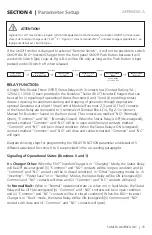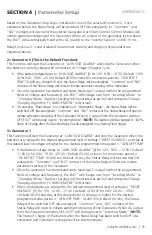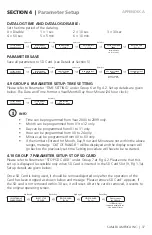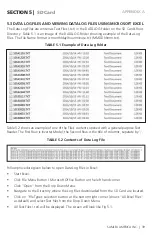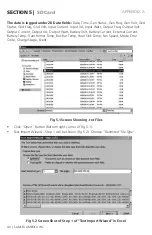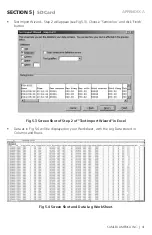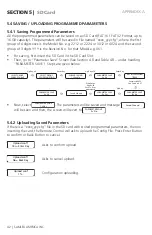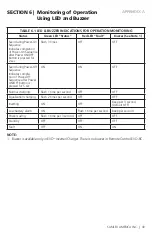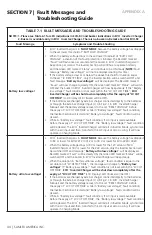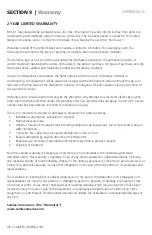
46 | SAMLEX AMERICA INC.
APPENDIX A
output short circuit!
EVO
TM
Inverter/Charger is in
FAULt MoDe
because there is a short circuit on the output
side in
inverter Mode
. Short circuit protection is activated when (i) the output current
is over 9.56 Arms for EVO-2212E/2224E, 13.0 Arms for EVO-3012E and 17.39 Arms for
EVO-4024E) and (ii) output voltage is less than 15 Vrms for 6 cycles (0.12 second for 50
Hz). (NOTE: Current is sampled every 33.3 µs)
•
There is no AC output because the Inverter Section has been switched OFF.
The Green LED marked “Status” will be switched OFF and the Red LED marked
“Fault” will be steady ON. The buzzer in EVO
TM
Inverter/Charger will beep steady
•
eVo
TM
inverter/Charger will be latched in oFF condition and will require manual
reset by powering oFF, waiting for 1 minute and then powering on again
note:
If there is short circuit condition in Charging Mode i.e. when AC input is
available, short circuit condition on the output side will trip the AC input breaker. The
load will be transferred to the Inverter Section and the Inverter Section will then see
short circuit condition and will shut down as described above
output failure!
EVO
TM
Inverter/Charger is in
FAULt MoDe
because AC input from Grid / Generator
has been connected to the AC Output terminals by mistake. 20VAC or above seen at
the AC Output Terminals
at the time of boot up of eVo
TM
inverter/Charger
will
activate this protection
•
The Green LED marked “Status” will be switched OFF and the Red LED marked
“Fault” will be steady ON. The buzzer in EVO
TM
Inverter/Charger will beep steady
•
eVo
TM
inverter/Charger will be latched in oFF condition and will require manu-
al reset by powering oFF, waiting for 1 minute and then powering on again
Check the connection. If there is 20V over at the output terminal, remove the connection.
transformer over heat!
EVO
TM
Inverter/Charger is in
FAULt MoDe
because the main Bidirectional Transformer in
the EVO
TM
Inverter/Charger has overheated to 150°C
•
The Green LED marked “Status” will be switched OFF and the Red LED marked
“Fault” will be steady ON. The buzzer in EVO
TM
Inverter/Charger will beep steady
•
If in Inverting Mode, Inverter Section will be switched OFF. If in Charging Mode, the
Transfer Relay will be de-energized and the Inverter Section will be switched OFF.
•
Check that the fans are working properly, there is no blockage of air suction
and discharge vents, adequate cool replacement air is available and the ambient
temperature is within the limits. Reduce the load / “BULK CURRENT” (Section 4.4)
•
The fault will be cleared when the transformer has cooled down to 80°C
Heat sink over heat!
EVO
TM
Inverter/Charger is in
FAULt MoDe
because the internal heat sink in the EVO
TM
Inverter/Charger has overheated to 70°C
•
The Green LED marked “Status” will be switched OFF and the Red LED marked
“Fault” will be steady ON. The buzzer in EVO
TM
Inverter/Charger will beep steady
•
If in Inverting Mode, Inverter Section will be switched OFF. If in Charging Mode, the
Transfer Relay will be de-energized and the Inverter Section will be switched OFF.
•
Check that the fans are working properly, there is no blockage of air suction
and discharge vents, adequate cool replacement air is available and the ambient
temperature is within the limits. Reduce the load and “BULK CURRENT” (Section 4.4)
•
The fault will be cleared when the heat sink has cooled down to 40°C
SD card unusable!
•
Data logging will not start.
•
Check that the format is FAT16/FAT32.
•
Check that the capacity is less than 16 GB.
•
Re-format the card.
SD card read error!
•
Data logging stops.
•
Remove and re-insert the card.
SD card write error!
•
Data logging stops.
•
Remove and re-insert the card.
SD card full!
•
Data logging stops.
•
Move or delete files or re-format the card.
WRite FAiLURe!
•
The entered value of programmable parameter could not be written. Call Technical Support.
oUt oF RAnGe!
•
The entered value of programmable parameter is out of the programmable
range. Change parameter value to within the specified range.
SECtION 7 | Fault Messages and
troubleshooting Guide


